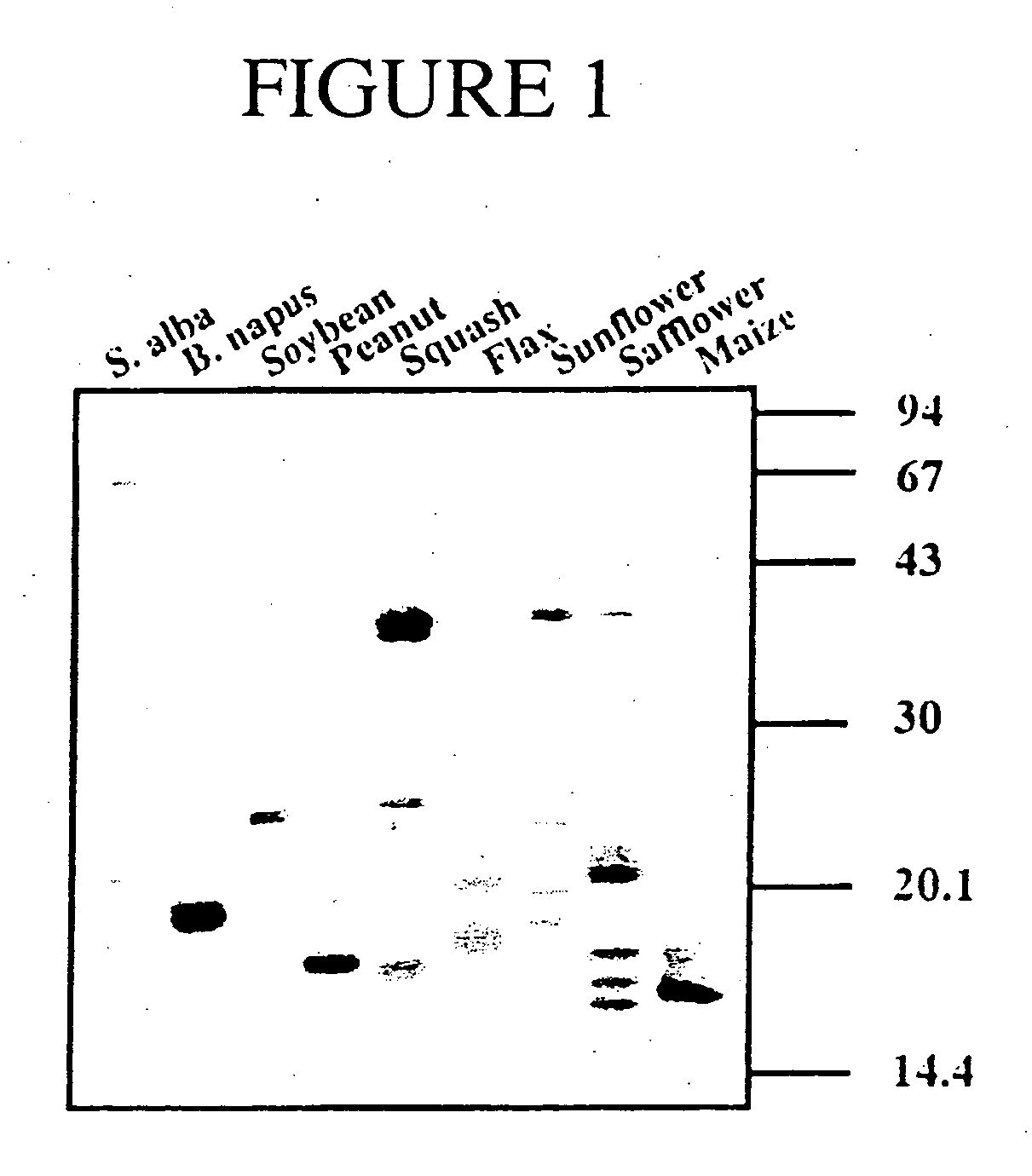Immunogenic formulations comprising oil bodies
a technology of immunomodulatory formulation and oil body, which is applied in the field of new immunomodulatory formulations comprising oil bodies and adjuvants, and can solve the problems of substantial loss of structural integrity of oil bodies in the course of these production processes, and substantial loss of structural integrity of oil bodies
- Summary
- Abstract
- Description
- Claims
- Application Information
AI Technical Summary
Benefits of technology
Problems solved by technology
Method used
Image
Examples
example 1
Obtaining a Washed Oil Body Preparation from Oilseed Rape, Soybean, Sunflower, White Mustard, Peanut, Squash, Flax, Safflower and Maize—Laboratory Scale.
[0158] Dry mature seeds obtained from Brassica napus cv Westar, soybean, sunflower, white mustard, peanut, squash, flax, safflower and maize were homogenized in five volumes of cold grinding buffer (50 mM Tris-HCl, pH 7.5, 0.4 M sucrose and 0.5 M NaCl) using a polytron operating at high speed. The homogenate was centrifuged at 10×g for 30 minutes in order to remove particulate matter and to separate oil bodies from the aqueous phase containing the bulk of the soluble seed protein. The oil body fraction was skimmed from the surface of the supernatant with a metal spatula and added to one volume of grinding buffer. In order to achieve efficient washing in subsequent steps it was found to be necessary to thoroughly redisperse the oil bodies in the grinding buffer. This was accomplished by gently homogenizing the oil bodies in grindin...
example 2
Obtaining a Washed Oil Body Preparation from Oilseed Rape, Sunflower and Maize on a Large Scale.
[0161] This example describes the recovery of the oil body fraction from canola, sunflower and maize seed on a large scale. The resulting preparation contains intact oil bodies and is comparable in purity with a preparation obtained using laboratory scale procedures.
[0162] Grinding of seeds. A total of 10-15 kgs of dry canola seed (Brassica napus cv Westar), sunflower (Helianthus annuus) or maize (Zea mays) was poured through the hopper of a colloid mill (Colloid Mill, Mz-130 (Fryma); capacity: 500 kg / hr), which was equipped with a MZ-120 crosswise toothed rotor / stator grinding set and top loading hopper. Approximately 50-75 litres of water was supplied through an externally connected hose prior to milling. Operation of the mill was at a gap setting of 1R, chosen to achieve a particle size less than 100 micron at 18° C. and 30° C. Following grinding of the seeds tap water was added to ...
example 3
Removal of Seed Proteins by Washing the oil Body Phase.
[0166] This example describes the recovery of a washed oil body fraction from canola, maize and sunflower seed. Using different washing conditions, it is shown that the washes result in the removal of significant amounts of seed proteins from the oil body preparation. These proteins include proteins which might be allergenic.
[0167] A total of 10-15 kgs of dry canola seed (Brassica napus cv Westar), maize (Zea mays) or sunflower (Helianthus annuus) was poured through the hopper of a colloid mill (Colloid Mill, Mz-130 (Fryma)), which was equipped with a MZ-120 crosswise toothed rotor / stator grinding set and top loading hopper. Approximately 50-75 l water was supplied through an externally connected hose prior to milling. Operation of the mill was at a gap setting of 1R, chosen to achieve a particle size less than 100 micron at 18° C. and 30° C. Following grinding of the seeds, tap water was added to the seed slurry to a final v...
PUM
| Property | Measurement | Unit |
|---|---|---|
| sizes | aaaaa | aaaaa |
| sizes | aaaaa | aaaaa |
| Malvern Size Analyzer | aaaaa | aaaaa |
Abstract
Description
Claims
Application Information
 Login to View More
Login to View More - R&D
- Intellectual Property
- Life Sciences
- Materials
- Tech Scout
- Unparalleled Data Quality
- Higher Quality Content
- 60% Fewer Hallucinations
Browse by: Latest US Patents, China's latest patents, Technical Efficacy Thesaurus, Application Domain, Technology Topic, Popular Technical Reports.
© 2025 PatSnap. All rights reserved.Legal|Privacy policy|Modern Slavery Act Transparency Statement|Sitemap|About US| Contact US: help@patsnap.com



